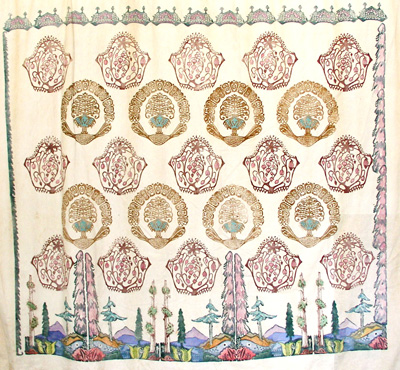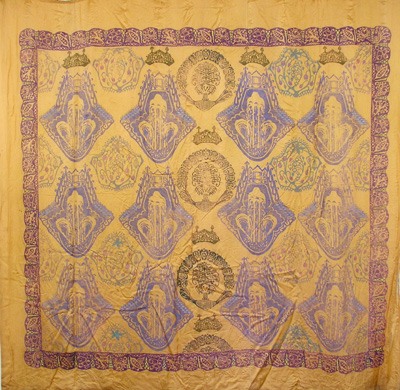|
Hewnoaks was the Maine home of the Volk family of artists. Located on the shores of Kezar Lake, it was also the heart of an Arts and Crafts community. Marion Volk decided to improve upon a generations-old native tradition of making “drawn” rugs and with the help of her son Wendell and daughter Marion she began Sabatos Handcrafts in 1901. A drawn rug is a type of hooked rather than woven rug. The Volks gathered together residents of Center Lovell, who then carried out every part of the rug-making process from tending and shearing sheep to formulating the indigo dye for which they were known. The only part of the process not done by hand was the carding—the wool was taken to “the old carding mill of South Waterford, the only carding mill in a country side of many miles extent.” The preparation for weaving a rug took one person seven days while the actual weaving was done at a rate of a half a square foot in a day. About twenty-five rugs were made in five years. The average size was 3’ x 5’ and they sold to “the curious summer resident” for about $50 each. |
|

Hewnoaks as it appeared in 2006. |
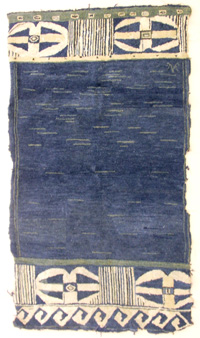
The first Sabatos rug, wool on burlap backing, 57 1/2“ x 33 3/4” .
|
The first Sabatos rug made was drawn upon a burlap backing. Its design was based on Native American patterns although the distinctive Sabatos indigo blue was predominant in the color scheme. They were evidently pleased with the design but not the structure of this prototype: The design appeared again on the cover of the brochure Wendell Volk printed from a wood block he carved. The brochure states that the burlap backing on this first rug was not acceptable. Wendell Volk wrote, “The first one was drawn through burlap, but this foundation was at once given up, as not being of the same durability of the pile.”
The Sabatos weavers were not an inconsequential, isolated phenomenon. The Volks had international connections that helped them make a significant contribution to the American Arts and Crafts movement. Sabatos-made looms were used at the Teachers’ College at Columbia University, the Ethical Culture School, the boys’ branch of the West Side Settlement School, and at Dr. Grenfel’s Mission in Labrador. Sebatos rugs won a silver medal at the 1904 Louisiana Purchase Exposition. Hull House in Chicago and the Troy School of Arts and Crafts in New York sought technical advice from the Volks.
|
|

The prototype Sabatos rug as it appered in a 1906 issue of Country Life in America.

Label and burlap backing on first Sabatos drawn rug.
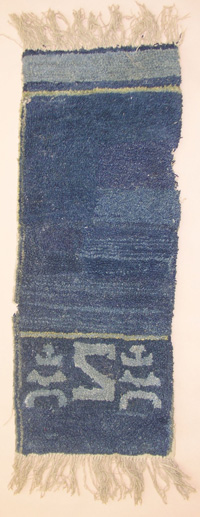
“S” for Sabatos woven into the design of a wool 47" long by 14 1/2" wide runner.

Detail of runner showing construction and Hewnoaks-woven wool foundation.

The portieres as they hung in Hewnoaks in 2006.
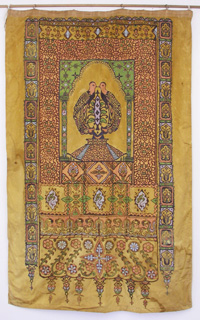
Block-printed silk panel, 70" long by 44" wide.

Detail of panel shown above.

Block-printed table cover, 51 1/2" by 50".

Tree block was also used on the cotton side of the portieres.
|

Marie Little rag rug design, circa 1904.
|
Sabatos produced woven, plain yard goods and narrow woven strips intended for use as portieres as well as rugs; the Indian motifs incorporated in the latter made them fine expressions of Arts and Crafts useful beauty. It is their utility that makes them precious rarities today. While there were a number of small rug-making enterprises flourishing at the turn of the last century, little of their product survived the hard use they were subjected to. Candace Wheeler of Associated Artists fame wrote a book about rug making, but few, if any, of her rugs survive. Her instructions and those of Helen Albee guided Marie Little in her rag rug production at the Byrdcliffe Arts and Crafts Colony, but most of her work that was used by the colony founders at their home White Pines was so worn as to be unrecognizable and was discarded when the Whiteheads’ heirs took over the care of the house in 1976. More of Dr. Grenfel’s rugs survive because their detailed scenes made them suitable for hanging on walls like tapestries. |
|

G. Meyers signed this panel along with seven others
|
The block-printed textiles found at Hewnoaks were made decades after the rug-weaving collaborative stopped although they were still the result of a community effort. Their designs and coloration are the epitome of the kind of style favored by American Fauve artists like Marguerite Zorach, who lived in Maine with her artist husband William and also made block prints. While the woodland scene at the bottom of the portieres is probably unique, the Persia-inspired motifs carved in linoleum were used in differing combinations to produce various panels. The portieres are the masterpieces of Hewnoaks craft production. The abstract fountain and tree vignettes were used again for a square table cover. No signatures have been found on these three pieces, but a third panel has no less than eight names hidden in the design, which is more directly based on Persian precedents than the portiere design.Offered as a group, these textiles reveal much about the Volks’ Arts and Crafts community in particular and the Arts and Crafts movement in general.
|
|















